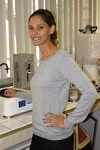Day :
- Track 1: Sustainable Food & Beverages Track 3: Fermentation and process equipment Track 5: Food and Beverages Packaging Track 7: Hurdle Technology
Session Introduction
Ingegerd Rosborg
Royal Institute of Technology, Sweden
Title: The importance of minerals from bottled waters

Biography:
Ingegerd Rosborg has completed her PhD at the age of 55 years from Lund University and performed additional studies and projects at both Lund University, Sweden, and KTH, Royal Institute of Technology, Stockholm, Sweden. She has been working as nutrient therapist and drinking water analysts and health evaluator at her company Miljö Näringsbalans Vatten (Environment Nutrient Balance Water) since year 2000. She has published more than 25 papers in reputed journals and has been COST Action 637, “Metals and related substances in drinking waterâ€, and IWA specialist group Swedish representative.
Abstract:
The study from 2002 presents the concentrations of about 50 metals and ions in 33 different brands of bottled waters on the Swedish market. Ten of the brands showed calcium (Ca) concentrations <10 mg L/1 and magnesium (Mg) levels <3 mg L/1; origin primary rock bedrock. Three of these had low concentrations of sodium ( <7 mg L/1), potassium (<3 mg L/1) and bicarbonate ( <31 mg L/1). Contrary, water with high concentrations can substantially contribute to the daily intake of elements. Nine of the brands were collected from limestone regions. They showed Ca-levels > 50 mg L/1, maximum of 289 mg L/1. Mg-levels were >90 mg L/1 in two brands. Two waters were supplemented with Na2CO3 and NaCl, resulting in elevated Na (644 and 648 mg L/1) and chloride (204 and 219 mg L/1). Such waters may make a substantial contribution to the daily intake of NaCl in high water consumers. The storage of carbonated drinking water in aluminum (Al) cans increased the Al-concentration to about 70 lg L/1. The levels of Fe (iron) and Mn (manganese) and potentially toxic metals were generally low. Nowadays bottled waters are more and more RO (Reverse Osmosis) treated, causing completely de-mineralized waters, comparable to distilled or rain water. Acute symptoms from drinking many Liters of RO water are decreased electrolyte levels causing tiredness, weakness, headache, trembling, coma, and brain edema. In the long run; acidosis, with increased risk for cardiovascular diseases, osteoporosis, diabetes etc is a great risk.
Sveinung Grimsby
Nofima AS, Norway
Title: Experimental product development through online grocery stores
Time : 14:00-14:25

Biography:
Grimsby has worked as a senior project manager at Nofima from 2006, coordinating EU projects as well as projects supported by various national founding agents. Grimsby had been accepted as a PhD candidate at the University of Oslo with his theses; “How does the Norwegian food industry act during innovation processes? -A study on new product failure rate and systematic differences between successful and unsuccessful innovation projects in the food industry.
Abstract:
Test sale through online grocery stores opens up for better consumer insights. A European FP7 SME research project named “Increased utilization and consumption of barley for better health” with the acronym BARLEYboost, tested new fiber enriched barleybread in order to develop a new cost efficient method for real-life testing of minimum viable food products (mvp’s). The experiment was conducted through the online grocery store www.kolonial.no in 2015. Free samples were handed out to known costumers with and without approved health claims, printed on the products. The health claim “Maintenance of normal blood cholesterol concentrations” due to its high on fiber from beta-glucan content, referred to at least 1g/meal as a necessary daily dose of 3g/day. The experiment indicated that health claims printed on the product had no significant effect on increased sales of barleybread. Mapping consumer behavior using big data technics at online stores, opens up for a new way of rapid prototyping with validated learning for the food industry. By studying behavior of barleybread consumers vs. average costumers, at the online grocery store, using social network analyzing methods, we find new patterns of consumers enabling us to group consumers in new segments. This will help us in more efficient mvp experiments for maximum learning, during new product development, in a new cost-efficient experimental design.
Suzana Caetano da Silva Lannes
Associate professor, Sau Paulo University, Brazil
Title: Quality and application of oils obtained from some brazilian species
Time : 14:25-14:50

Biography:
Suzana Caetano da Silva Lannes is Associate Professor at Pharmaceutical Sciences School at University of São Paulo. She is President of Brazilian Society of Food Science and Technology-sbCTA, and Vice President of Brazilian Association of Rheology. She has published papers in reputed journals, book chapters, and has been serving as Editor in Chief of Food Science and Technology-CTA Journal. Develop research works in the Food Science and Technology area, on the following subjects: rheology, physics of foods, development of special and nutritional food formulations and study of fats and some fat foods.
Abstract:
Brazil has considerable territorial peculiarities and plant species diversities, sometimes from the same botanical family. The fruits can exhibit significant differences in properties of the oils extracted. As example can be cited Brazil Nut (Bertholletia excelsa), Sapucaia nuts (Lecythis pisonis camb.), Amazonas tucumã (Astrocaryum aculeatum Meyer), Pará tucumã (Astrocaryum vulgare Mart.), Chicha (Sterculia striata), Peanut (Arachis hypogaea L.) among other. The raw materials of great relevance, as oils from seed and pulp, have been widely investigated due to its lipid content and potential application, fatty acid profile, and bioactive compounds. The extration process can interfere in some properties of the obtained oils, as quantity and quality of their unsaturation profile, directly influencing the nutritional quality of these oil, for example, with regards to quantitatively unsaturated fatty acids, as well as total carotenes. Thermal analysis has been used in studies on thermal decomposition, moisture determination, volatile compounds, thermal oxidation, reaction kinetics, crystallization, phase diagrams, specific heat determination, vitreous transition determination, storage time determination. And it can be useful to characterize the properties of the oils and fat foods. Oils are responsible for performing varied and important functions in the body, such as providing calories, essential fatty acids and fat soluble vitamins, and are considered very important among the ingredients and the sensory aspects of the functional properties of the food. The final characteristics of processed fat products depend on the physical and chemical properties of oils and fats present in their formulation.
Romdhane Karoui
Artois University, France
Title: Front-face fluorescence and infrared spectroscopies: A tool for the authentication of food products
Time : 14:50-15:15

Biography:
Romdhane Karoui obtained his PhD in Food Science in 2004 from Blaise Pascal University (France) and his accreditation to supervise research in 2009. Between 2009 and 2010, he was the Senior Research Scientist at Gembloux Agro-Bio Tech (Belgium). He has a long-term scientific experience in the fields of Spectroscopic methods (VIS, NIR, MIR, fluorescence) for the determination of the quality of several food products. He is the author of 75 peer-reviewed scientific papers and more than 80 proceedings, book contributions and reviews. He is serving as an Editorial Board Member of several journals in Food Science. He is currently working as a Professor at the Artois University and Director of the research team of Food Quality and Security Site-Artois of Charles Viollette Institute.
Abstract:
Food adulteration has been practiced since a long time and sophisticated foods have increased in the last years. Foods and ingredients presenting high-value are the most vulnerable for adulteration. Determination of food authenticity and detection of adulteration have become an important question in quality control and safety of food products. Indeed, consumer awareness has increased about food quality and safety, geographical origin and agricultural. The replacement of original substance partially or completely with more easily available and cheap substance is the most common procedure performed by defrauders. Although the physico-chemical analyses are promising techniques to determine the authenticity of food products, they are time consuming and use several pollutant reagents. For these reasons, there is a need to develop rapid, inexpensive and efficient analytical methods for the detection of frauds and authentication of food products. Recently, more attention has been paid to the development of noninvasive and non-destructive techniques such as infrared, fluorescence, and so on. These techniques are fast, of relatively low cost, environmentally friendly, and provide a great deal of information with only one test, making them suitable for on-line and/or at-line process control. In addition, the above-mentioned techniques often require little or no sample preparation and are relatively easy to operate. The aim of the present study was to determine the potential of mid infrared and fluorescence methods combined with multivariate statistical analyses as fingerprints allowing authenticating different food products.
Carola Seybold
Director, X-Rite GmbH, Germany
Title: How color can influence the success story of your food company
Time : 15:15-15:40

Biography:
Carola Seybold has completed her Diploma at the age of 24 years from Lake of Constance University (GRMY) and further finalized her Marketing studies from University of Hohenheim (GRMY). Before joining PANTONE LLC in 2008, Seybold has worked as a Senior Consultant at Glasmeier & Partner Int. She works as the Director of Business Development for PANTONE LLC in Europe, Middle East and Africa and leading also the Marketing in PANTONE EMEA.
Abstract:
Have your ever make up your mind, how important it is to have the right, consistent color for your produced food? Do you know, that also color trends influencing the consumer purchase behavior in food? Learn from different case studies, what are the challenges and risks in color selection, color development and color sustainability. PANTONE will introduce you, how color perception is working, which colors have which meaning for food and how colors can be controlled in a global production process.
Felix Schmollgruber
X-Rite Europe GmbH, Switzerland
Title: Colorize your flavor - Color measurement for food
Time : 15:40-16:05

Biography:
Felix Schmollgruber studied printing and media technology at the University of Applied Sciences in Munich Germany and started his professional career in June 2001 at GretagMacbeth, Germany accepting the challenge to explore industrial color management in a variety of industries. After six successful years as field sales manager at both GretagMacbeth and X-Rite he moved into the European headquarters of the freshly merged company in Switzerland to serve as technical support engineer and trainer in order to help customers implementing and troubleshooting X-Rite solutions. Today he leads the group of application- and technical support specialists for X-Rite’s EMEA territory.
Abstract:
Human nature judges the quality of food visually prior to smelling or tasting. Nevertheless color measurement of food specimen presents a number of challenges given the physical properties of certain products, like samples changing when in contact with an instrument, the instrument contaminating etc. This lecture will cover the basics of color measurement, available technologies to overcome the obstacles of food specific problems with traditional measurement devices and how to establish repeatable and representative characterization and specification of food color. Furthermore success stories of food processors best practices in regards to color will be presented.
Oya Bozdag Dundar
Ankara University, Turkey
Title: Anticancer activity mechanisms of flavonoids
Time : 16:30-16:55

Biography:
Oya Bozdag Dundar has completed her PhD from Ankara University in 1998. She is a full Professor at the same department since 2009. She has been lecturing to BSc, MSc and PhD students in Ankara University, Faculty of Pharmacy, Department of Pharmaceutical Chemistry. She published 59 articles and is interested with drug design and synthesis of heterocyclic compounds having antidiabetic, aldose-reductase enzyme inhibitory, antioxidant, histone deacetylase enzyme inhibition, bromodomain inhibitors and anticancer activities.
Abstract:
Flavonoids are a vast group of heterogeneous polyphenols with various health benefits, derived from secondary metabolism of plants. They are ubiquitously found in fruits, vegetables, tea, and wine. Chemically, flavonoids are classified into several subclasses among them are flavones (2-phenyl-4H-benzopyran-4-ones), aurones (structural isomers of flavones; 2-benzylidene benzofuran-3(2H)- ones) and 2-styryl chromones (vinylogues of flavones). Low molecular weight polyphenolic phytochemical flavonoids play important role in various biological processes at nontoxic concentrations in organisms. Therefore, flavonoids are important components of the human diet. Many natural products belonging to the flavonoid subclasses possess anticancer activity like quercetin and apigenin (flavones), hamiltrone (aurone), hamilcone (chalcone) and hormothamnione (styrylchromone). The role of dietary flavonoids in cancer prevention is well established and widely discussed. Many mechanisms of their action have been identified including cell cycle arrest, induction of apoptosis, inhibition of angiogenesis, antioxidant effect and inhibition of some functional enzymes like cyclindependent kinases, tyrosine kinases, aromatases, topoisomerases, glycogen phosphorylases and reversal of multidrug resistance or a combination of these mechanisms. Naturally obtained flavone moiety having a variety of biological activities can be taken as lead compound for the synthesis of synthetic flavone derivatives with different functional groups at different positions of flavone skelton.
Sylvain Ramanarivo
Professor, University of Antananarivo, Madagascar
Title: Strategic reorientation of agricultural development for food security and sustainable development in sofia region

Biography:
Sylvain RAMANANARIVO is Full Professor at Ecole Supérieure des Sciences Agronomiques at University of Antananarivo and Deputy General Manager at Ecole Supérieure de Management et d’Informatique Appliquée (ESMIA). His main researches are focused on the farming system, the value chain and the food security.
Abstract:
Madagascar is extremely rich in biodiversity and has a high agricultural potential. However, poverty is still increasing and food insecurity problems remain. As 80% of the population lives in rural areas, promotion and adoption of a relevant agricultural policy will help to overcome those scourges that obstruct the country development. The analysis of agricultural policies shows that there is no real continuity between various policies adopted in Madagascar. During the first Republic, the policy was mainly based on agricultural sector development especially rice and industrial crops. During the recent decades, it has been focused on agricultural diversification or on systems approach. Nowadays, new trends of rural development organizations argue for value chains development. In this research, the main question is: which strategies should be adopted for implementing a regional agricultural development policy to overcome food insecurity? The research has been developed in three steps: (i) dynamics of production systems analysis at farm level, (ii) identification of potential chain value within a region and assessing their competitiveness; (iii) and finally, determination of agricultural development strategies at regional level. Indeed, Malagasy farmer logic is based on the speculations headlights which remain inseparable to complex systems of agricultural production. "Acting on flagship component for acting on the system", equivalent to the optimization of production factors on potential speculation, allows to maximize farmers’ income. In addition, the development of promising sectors, as flagship speculations even in mono-activity in a region and its territories, optimizes household income. Besides, the development of agricultural strategy must combine "systems approach and value chain approach"; it should be based on the optimization of production factors and the improvement of the environment of the value chains to support food security and sustainable development at regional level.
Ahlam Badreldin El Shikieri
Associate professor,Taibah University, Saudi Arabia
Title: Fruit and vegetables’ consumption among children and adolescents: Trends, Determinants of consumption and possible solutions

Biography:
Ahlam Badreldin El Shikieri has completed her PhD from Queen Margaret University, and has an MBA from Leicester University, UK. She is a registered Consultant Nutritionist, a Certified Public Health Nutritionist and an Associate Professor currently working in Saudi Arabia. She acted as an invited speaker at several workshops and conferences in Sudan, Saudi Arabia, Spain and Taiwan. She supervised several research projects for students both at Master and PhD levels and acted as an external examiner for postgraduate thesis in several universities. She taught nutrition, research and management related modules at the graduate and undergraduate levels. She designed pamphlets for patients with diabetes mellitus, obesity and cancer. She undertook several researches focusing on assessing the nutritional status of cancer patients, children, malnourished hospitalized patients and many others related to public health nutrition. She is a member of the Academy of Nutrition and Dietetics, British Nutrition Society, World Public Health Nutrition Association and others. She is a reviewer for various journals including the Journal of Nutrition Education and Behavior and has acted as an author for more than 15 published research papers and newsletter articles.
Abstract:
Nutritional health during childhood and adolescency is important for supporting the growing body and for preventing future health problems. Fruits and vegetables are important components of a healthy diet. Their consumption varies considerably among and within countries. Large proportions of children do not fulfil the World Health Organization recommendation of eating fruit and vegetables per day. Reduced fruit and vegetables’ consumption is linked to poor health, constipation and increased risk of noncommunicable diseases including cancer. The dietary fibre available in the outer skin of these foods could help to lower blood pressure, and together with phytochemicals such as plant sterols, flavonoids and other antioxidants found in fruit and vegetables may be important in modulating cholesterol and other biological processes. In addition, obesity and overweight among this age group is being linked to low intake of fruit and vegetabhles. The determinants for high consumption levels of fruit and vegetable are found to be related to female gender, low age, high socioeconomic status, high preferences for fruit and vegetables, large parental intake of fruit and vegetables and high availability/accessibility of fruit and vegetables at home as well as peer influence. Possible solutions to improve fruit and vegetables’ consumption include behavioural interventions and improvements in agricultural and food systems. Results from Sudan and Saudi Arabia will be discussed.
Haleama Al Sabbah
Professor, Zayed University, UAE
Title: Smoking (Waterpipe and Cigarette) and obesity among university students in uae and palestine: Cross-sectional study

Biography:
Haleama Al Sabbah is working at Zayed University, Dubai at the Public Health Nutrition Department since Sept. 2013. Haleama has completed her Ph.D in Public Health Nutrition in 2008 from Gent University-Belgium. She got Master in International Community Health with special focus on Diabetes Self-Management in 2000 from Oslo University-Norway. Haleama was a Fulbright Visiting Scholar, did her Post-Doctoral studies in Nutrition at Tufts University, Jean Mayer Human Nutrition Center (2011-2012).
Abstract:
To assess the Prevalence rate of water pipe smoking behavior among university students in West Bank and Dubai and determine the factors associated with water pipe smoking among young people. Design: Cross-sectional study. Setting: 5 universities in West Bank- Palestine and 5 universities in Dubai- UAE. Participants: 3800 students randomly selected with a response rate of 87.6%. Measurements: Self-administered questionnaire was used to collect the data. The key measures were waterpipe smoking, weight, height, cigarettes smoking, dieting to reduce weight, perception and knowledge related waterpipe smoking. Weight, height and waist circumference were measured from a subsample of 500 students. Body Mass Index (BMI) was calculated using the WHO cutoffs to identify obese, overweight and underweight students. Findings: In total, 3327 students (54% West Bank and 46% Dubai) included in this analysis. In Dubai, 22% were overweight, and 9% were obese. In West Bank, 14% were overweight, and 4% were obese. 16% in Dubai and 18% in West Bank smoke cigarettes. Quarter of the students in Dubai (26%) and 32% in West Bank smoke waterpipe. 17% in Dubai and 18% in West Bank smoke waterpipe in order to reduce their weight. Significant associations were found between smoking waterpipe and obesity, overweight, and abdominal obesity (p<0.001), Conclusions: Waterpipe smoking is common among university students. Smoking waterpipe is associated with BMI and abdominal obesity. Programs aimed at education, prevention, and intervention for waterpipe use are needed to address the high prevalence rate of waterpipe smoking and this growing public health concern.
Lucia Valverde-Som
PHD Fellow, University of Granada, Spain
Title: Chromatographic fingerprinting for food authentication

Biography:
Lucia Valverde-Som are PhD students in Analytical Chemistry; González-Casado is currently Tenured Professor of the Department of Analytical Chemistry; Ruiz-Samblás is PhD and researcher hired by the University of Granada; Cuadros-RodrÃguez is Full Professor of the Department of Analytical Chemistry. They work in the same research group "Analysis in Food and Environment". The members of the research group have published more than 150 papers and they work in different projects about virgin olive oil.
Abstract:
Food authentication involves the confirmation of the stated specifications as true. This is a needed requirement because the authentication is bound to the truthfulness and food is considered authentic when it is not affected by any fraud. There are different strategies to perform food authentication. These strategies are dependent of the scientific-technical problem and the type of available analytical information. There are three analytical approaches to study food authentication: (i) to obtain the chemical composition of the food (chemical approach); (ii) to work about biomolecular level (biomolecular approach); (iii) to focus about stable isotopic composition of certain atoms (isotopic approach). Chemical approach are divided in different methodologies: (a) analytical data, which represent the chemical species and chemical markers; (b) compositional profiles, which describes constituents and it gives specific information on particular chemical components; (c) instrumental fingerprints, which contain unspecific and non evident information which should be extracted by chemometric tools. The fingerprinting methodology is based on treating the entire or a part of the instrumental signal as a whole, without identifying or quantifying each compound. There is a great benefit which is the decreasing in time of analysis but it requires the use of chemometrics tool, are essential to extract behaviours, trends or significant information from the data. The aim of this communication is to explain the use of chromatographic fingerprinting for food authentication with different chromatography techniques and the advantages of this methodology.
Mukhamad Najib
Researcher, Bogor Agricultural University, Indonesia
Title: Consumer behavior and marketing strategy towards organic food in the emerging market

Biography:
Mukhamad Najib has completed his PhD from Department of Agricultural and Resource Economics, the University of Tokyo. He has been teaching and doing research in Bogor Agricultural University since 2006. Now, He is the head of Department of Management, Faculty of Economics and Management, Bogor Agricultural University. He has published many papers related to food processing industry, small and medium enterprises as well as agricultural and food marketing. He wrote two books about strategic management and marketing. He is actively promoting food security agenda in Indonesia by strengthening the role of farmer’s group as significant actor in mantaining food availability in rural area.
Abstract:
Growing consumers’ concerns on food safety, health and environment in the recent decade has resulted increased demand for organic food across the world, including emerging economies such as Indonesia. It is important for food producers to understand the behavior of consumers toward organic food so that they can develop appropriate marketing strategy to deal with their competitors. In this paper we present the result of an empirical study of consumer behavior and marketing strategy towards organic food products in Indonesia as emerging market. We provide the description of Indonesian consumers’ perceptions and attitudes concerning organic food based on the field research. The purposes of this study are: (1) to analyze consumers’ perceptions and attitudes of organic food products, (2) to analyze factors influencing consumers buying decision and (3) to analyze marketing strategy of organic food producers in Indonesia. In this case, rural and urban area can be geographic factors affecting different perception among consumer to organic food. A quantitative survey with a sample of 200 consumers living in rural and urban area was conducted to explore consumers’ perception and attitudes related to organic food. Structural Equation Model used to analyze factors influencing consumers buying decision. Three factors affecting consumers’ buying decision will be examined in this research are as follow: (1) attitude, (2) subjective norm and (3) affordability. The results show that there are significant differences between rural and urban consumers in term of perception and attitude to organic food meanwhile subjective norm and affordability influence consumers buying decision significantly. Market education and suitable pricing strategy can be success factors for food organic producers to compete in the Indonesian market.
Maryam Bahram-Parvar
Postdoctoral fellow, University of Guelph, Canada
Title: Novel intrumental analytical methods for quality control of frozen desserts – A review

Biography:
Maryam Bahram-Parvar has completed her PhD in Food Science and Technology at the age of 28 years from Ferdowsi University of Mashhad, Iran, collaboratively with University of Guelph, Canada, in 2012. She is currently working as postdoctoral fellow in the Department of Food Science at University of Guelph. Maryam’s highly significant contributions to her field includes more than 15 peer-reviewed journal articles, 2 books, and numerous conference presentations. She has also served as a an active reviewer for several top ranking journals, including “Critical Reviews in Food Science and Nutritionâ€, “Food Hydrocolloidsâ€, “International Journal of Dairy Technologyâ€, so on.
Abstract:
Physico-chemical analyses are commonly used for measuring quality aspects of ice cream and related products. However, these methods are time consuming, need large quantity of sample and lots of pollutant reagents, and in some cases, obtain limited knowledge of proporties of the products. Consequently, the is a growing demand of the food industries and research institues to have new means of measurements with higher capabilites. Alternative techniques have been introduced to characterize frozen desserts, as complex foods, including rheometry, spectroscopy, X-ray, electro-analytical techniques, ultrasound, and laser, however their application is few. This review discusses the potential of destructive and non-destructive methodologies in determining the quality and characteristics of ice cream and similar products, such as emulsions and foams. Determining the interfacial properties, droplet size distribution, influence of formulation on ice cream structure, and thermo-mechanical properties, visualization of the 3D microstructure, control of freezing, detection of microbial concentration, quantification of different populations of protein in an emulsified system, etc. are of potential applications of novel techniques in ice cream testing. Some of the techniques have demonstrated considerable potential for transferring to the dairy plants as either on- or in-line methods and may be applied nondestructively. However, an accurate determination of the quality and/or identity of frozen dessert seem feasible only when a combination of all parameters is considered and different tests are used.
Himjyoti Dutta
Assistant Professor, Amity University, India
Title: Dry heat parboiling – An altered method to improve quality of rice

Biography:
Himjyoti Dutta has completed his PhD in 2015 at the age of 31 years from Tezpur University. His research interest primarily includes processing of paddy for value addition and starch modification for targeted commercialization. He is presently working as an Assistant Professor in Amity Institute of Food Technology. His publications include 10 research articles and 1 review article in eputed journals.
Abstract:
Parboiling is a popular post-harvest paddy processing practice in India, Pakistan and African countries. Conventional parboilng involves hydration of paddy by soaking in water followed by open steaming. Steaming under high pressure is a more recent technique practiced for industrial production of parboiled rice. Steaming is followed by drying under the sun or ovens and milling to produce staple grains. A third type called dry heat parboiling involving roasting previously soaked paddy or rice using heated sand or hot pan was earlier considered to produce only speciallity products like popped and puffed rice. However, this process involving instant heating at high temperature also encompasses the molecular changes as seen in steam parboiled rice. The step of drying is not necessary here because extensive drying occurs simultaneously during the heating step. In this study, dry heat parboiling of sufficiently soaked paddy with distinctly differnt amylose content was carried out under controlled conditions of temperature and time. Neither popping of paddy nor excessive puffing of the gelatinized kernels were allowed. The technique resulted in increased kernel hardness resulting in high head rice yield. Excessive damage to the amylopectin resulted in high water uptake properties and gave a continuously rising RVA pasting curve. XRD and DSC analyses indicated formation of starch-lipid complexes. Waxy rice varieties with no amylose content also showed the corresponding peaks, cofirming complex formation amongst amylopectin and lipid after parboiling. Occurence of retrogradation on adding water to gelatinized starch in DSC pan was evident. Dry heat parboiling also notably increased the digestibility of starch in all the varieties. The technique can therefore be effectively used for commercial paddy parboiling to produce staple rice for targeted population groups.
Biography:
Abstract:
- Track 9: Recent Trends in Food & Beverages Track11: Food & Beverages Market Track 13: Entrepreneurs Investment Meet
Session Introduction
Amir M. Mortazavian
Associate Professor, National Nutrition and Food Technology Research Institute, Iran
Title: Isolation of very tolerant probiotics for food application from native Iranian products

Biography:
Mortazavian (Associate Professor of Shahid Beheshti University of Medical Sciences) was born in 1978 in Iran. He was graduated (MSc and PhD of Food Technology) from University of Tehran (Iran). His professions are Dairy and probiotic technology. He has published 7 books and more than 100 research articles. He has many national and university research awards and honors; and is a member of Iran National Élites Foundation. Dr. Mortazavian is Vice President of Educational Affairs in faculty and the manager of Students Research Center at University as well as consultant of some governmental organizations. Beside science, he is a professional pianist and has several publications on classic music.
Abstract:
Nutraceutical effectiveness of probiotics in foods is determined by the rate of probiotics viability in final products at the time of consumption. The amount of 107 cfu ml-1 is recognized as the minimum level. The main vegetative (non-spore formers) probiotics used in foods belongs to genera Bifidobacterium and Lactobacillus. The greatest drawback of food probiotic technology is viability loss of probiotic cells during processing and particularly, during the storage time due to their susceptibility to the harsh conditions of products. pH and acidity, molecular oxygen, and time and temperature of storage are the most detrimental factors. Furthermore, if a high number of viable cells have been protected in products by any method, it is not guaranteed that the same numbers would be reached to the intestine owing to the exposing the cells to very harsh in vivo conditions. Although much has been investigated and published about improvements on food formulations and processes in order to make them more adjustable to probiotic strains nature, practically and economically, the best way is to use tolerant strains. We have isolated and modified numerous Iranian native probiotic strains with outstanding resistance to very harsh conditions of fermented milk drinks, fruit juices and beer. Recently, these strains are industrially manufactured and sold to dairies in Iran and are being marketed in other countries. In this article, the resistance characteristics of mentioned probiotic strains (bifidobacteria and lactobacilli) to foods and simulated GIT are discussed. This new generation of probiotic strains can evolve the food probiotic technology.
Mario Ciampolini
University of Florence, Italy
Title: Diabetes, loss of attainment of low BG as well as of the hunger (IH) after meal suspension

Biography:
Mario Ciampolini (born 1933) directed the Gastroenterology Research Unit, a third level referral center in the department of Pediatrics of the University of Florence (Meyer hospital) for 40 years. I worked at the Cornell University for a joined research with the University of Florence on energy expenditure in children. Three students came from Amsterdam Medical Center to learn “Recognizing Hunger†I published 130 scientific articles, about 40 in international Press. A long term strategy was designed with Giuliano Parrini, prof. of Physics (Firenze, It), Andrea Giommi, prof. of Statistics (Firenze, It), and Cutberto Garza, Boston College, Rector
Abstract:
Hunger can be taught; Initial Hunger Meal Pattern (IHMP = Three Initial Hunger (IH)) arousals per day) decreases energy intake, mean preprandial BG, body weight, insulin resistance and fecal energy loss. The sequence of 21 preprandial BG measurements in a week (Mean BG) characterizes individual meal pattern, is stable through months and is negatively associated to insulin sensitivity. An even energy balance in blood is the healthy goal of eating and is indicated by low mean BG (76.6 ± 3.7 mg/dL),
Biography:
Abstract:
Biography:
Abstract:
Giuliano Elias Pereira
Researcher, Brazilian Agricultural Research Corporation-Embrapa Grape & Wine/Tropical Semi-Arid, Brazil
Title: Characteristics of tropical wines produced in a new latitude of Brazil

Biography:
Giuliano Elias Pereira has completed his PhD at the age of 33 years from Bordeaux University (France). He is researcher of the Laboratory of Enology at Embrapa in Petrolina-Brazil, He has published more than 40 papers in reputed journals. He is Professor in two Universities, Master of Science in Irrigated Horticulture at University of Bahia Estate-Brazil, about Viitiviniculture and Tropical Enology, and Masters in Food Science, lecturing Technology of Beverages at Federal University of Sergipe-Brazil.
Abstract:
Wines are traditionally produced in temperate climate zones, in the North and South Hemispheres, with one harvest per year, between August and October in the North, and between December and March-April in the South. Tropical wines are a new concept of vitiviniculture that is being developed in Thailand, India, Myanmar, Venezuela and Northeast of Brazil. The new Brazilian frontier is located between 8-9º latitudes of the South Hemisphere. Grapes and wines from this region present peculiar characteristics, being possible to harvest grapes and winemaking all months of the year, and one vine produces two times per year, due to the high temperature, with annual average of 26.5ºC, high solar radiation and water availability for irrigation. Tropical wines from Brazil have presenting interesting chemical characteristics, because metabolite profile can change according to the harvest date. The temperature during maturation and harvest has a high importance for grapes and wine composition. For the first period, the maximum temperatures are about 30-32ºC for days, and the minimum 18-20ºC at nights, having an interesting amplitude for grapes. In the other hand, for the second period of production, high temperatures are observed, between 32-35º for nights and 40-45ºC during days. It can be observed wines presenting different characteristics if they were elaborated in the first or second periodos of the year. Works are been carried out to understand effects of the season on grape and wine characteristics. Results are presented and discussed, showing mainly phenolic and aromatic compound evolution according to the harvest date.
Gail Barnes
Personify LLC. USA
Title: How packaging innovation can increase children's school milk consumption

Biography:
Gail Barnes is a technical expert and strategic partner to processors, manufacturers and packaging suppliers, providing insights on sustainability, product innovation, consumer insights, food safety and regulatory processes and procedures.She has previously served as vice president of technology and packaging for the Innovation Center for U.S. Dairy and Dairy Management Inc.â„¢ In this position, she helped the dairy industry realize its sustainability goals by working as an expert resource internally and directly with processors, manufacturers and transporters.South African born and educated, Barnes has a Master of Science in Biology and a Ph.D. in Applied Chemistry (Food Science Division) from the University of Natal. She earned her Master of Business Leadership from the School of Business Leadership at the University of South Africa.
Abstract:
The presentation will show the results of studies indicating that children prefer milk in plastic or carton bottles and that they will consume more milk, more often, when it is presented in a bottle format. The cost of plastic bottles made with traditional technology has however sometimes meant that schools in the U.S.A. have not been able afford to provide school milk in plastic bottles. This presentation will describe an innovation in how plastic bottles are made, using patented thermoforming film-to-bottle technology, which significantly reduces the cost of plastic bottles. Since this type of thermoforming technology could save 30%-50% in material over traditional extrusion blow molding, its use could put plastic bottles within reach of more U.S.A. school milk programs. The result of more milk available in schools in a format that children prefer could result in maintained/increased school milk consumption, and the possibility of retaining children as lifelong milk consumers. Maintained milk consumption is of particular importance of for girls of school age in terms of the prevention of osteopenia and osteoporosis in later life.
Eliyeh Ganji
University of Gottingen, Germany
Title: Improving germination percentage and rate of barley (Hordeom vulgare L. ) seeds by using ultrasonic waves and the reasons for this improvement

Biography:
Eliyeh Ganji is a M.Sc. student from University of Gottingen. She has published more than 4 papers in reputed national conferences.
Abstract:
Improving germination percentage and rate of barley (Hordeom vulgare L. ) seeds by using ultrasonic waves and the reasons for this improvement: Barley is the main ingredient for malting and brewing in the manufacture of beer. Germination capacity and the level of α-amylase in barley grains plays a significant role in the brewing process of barley. Poor germination capacity of barley reduces malt yield. In order to study the effects of sonication on seed germination percentage and rate as well as the endospermic cells’ area of barley a laboratorial experiment was performed as Completely Randomized Design (CRD) with 3 replications. The results indicated that the ultrasonic waves affect the seed germination, the germination rate and the cells’ area significantly (at 0.01). The results of mean comparison tests (LSD, 0.05) showed that the highest germination percentage (100 %), germination rate and cell area (1370.71 micron) is achieved through 15 minutes exposure to ultrasonic waves. It is concluded that sonication could weaken the seed cells’ wall rigidity and make micro-pores on the cell’s wall resulting in higher and faster water imbibition by the cells. Eventually, higher absorption of water increases the α-amylase activity followed by faster hydrolysis of starch so that germination percentage and rate increase.
Biography:
Abstract:
Ana Lucia Vasquez Caicedo
Fraunhofer Institute, Germany
Title: Integrating new technologies in dairy operations to reduce overall water and energy consumption

Biography:
Ana Lucia Vásquez-Caicedo obtained a MSc in Food Science and Technology from the University of Arkansas (USA) and a PhD from University of Hohenheim (Germany). She has experience on product and process development in the fruit and vegetables, bakery, dairy and the beverage sectors. Ana Lucia joined Fraunhofer IGB in 2009 and leads the group “Aseptic Technologies†focusing on process development for the stabilization of foods and manufacturing of cosmetic ingredients. Her experience includes development of innovative processes and their integration into established manufacturing processes, conducting risk analyses and evaluating the impact of introducing new technologies.
Abstract:
With 13% of the total European Food and Drink industry turnover, the dairy industry is considered one of the most important sub-sectors as well as and one of the highest energy and water consumers, both overall and per unit production: up to 6.47 MWh (5.55 MWhth and 0.92 MWhel) and an average of 2 m3 of water per tonne processed milk. The production of milk powder and other dairy powder products in the EU has risen continually in recent years due to increased export demand, thus having a major impact on overall water and energy consumption in EU dairies. Therefore, the whole processing line of these products was analyzed and hot spots identified. Pre-heating of concentrates (45-52% solids) and/or viscous products like yogurt and quark prior spray drying remain one of the major challenges due to the formation of fouling and burn-on, which impacts on product quality and creates costs associated with downtime for cleaning and maintenance. Accordingly, microwave pre-heating technology has been identified as a promising alternative to indirect heating using plate heat-exchangers or tubular heaters. Current experiments with quark, a fresh cheese-like a microgel suspension, have shown no fouling formation and homogeneous product quality enabling longer processing times and substantial reduction of cleaning efforts. Additionally, rapid microwave pre-heating to a temperature inlet of 50°C increased spray dryer throughput by 11%. Presently, studies on overall energy consumption with an integrated microwave pre-heating unit are being conducted at an industrial site.
Biography:
Abstract:
Biography:
Abstract:
- Symposium on "Sustainable Food Production: A Technological Approach to Reduce Water and Energy Consumption in Dairy Industry"
Session Introduction
Christoph Glanser
Fraunhofer Institute (UMSICHT), Germany
Title: The green dairy model: A technology and innovation-driven approach for sustainable milk processing
Time : 10:00-10:25

Biography:
Christoph Glasner is working as a Senior Scientist at Fraunhofer Institute for Environmental, Safety, and Energy Technology UMSICHT. He has completed his studies of Mechanical Engineering with a specialization in Process Engineering in 2005. He got his PhD in the field of oil filtration with several separation/membrane technologies in 2009. The PhD thesis was carried out within the framework of 2 FP6 EU projects that he was managing (TRANSMAN, SAFELUBE). Since 2009, he is the Senior Scientist at UMSICHT in the field of biomass conversion and water treatment/management in combination with heat recovery. Currently, he is responsible for international projects in the field of food processing and biomass utilization.
Abstract:
The main idea of the collaborative project “SUSMILK: Re-design of the dairy industry for sustainable milk processing” is to analyze and optimize the whole process chain for milk and milk products with regard to energy and water consumption. The project aims at developing new concepts and technologies for the supply of heat, cold and power and integrating them into the respective process steps. A central part of the project is the integration of innovative and efficient technologies into a green dairy concept that will aim at maximizing water and energy savings. Main objectives include: application of new technologies for heat generation and distribution in dairies; adaption of new chilling technologies; application of membrane filtration techniques for an innovative pre-concentration of milk; development of new concepts for low temperature drying of milk; optimizing/classifying of waste-stream treatments for water savings and/or energy production; testing of all technologies and concepts in pilot applications under real life conditions; LCA of the entire dairy food chain and development of a decision making tool for more competitive and green dairy plants and; energy-based analysis to show the full potential of energy and water savings within the dairy industry. Expected results include: The evaluation of the feasibility, efficiency, and economy of the technology developments to reduce the water and energy demand in the dairy to establish a resource efficient food processing; concepts based on research results to highlight the potential for recycling of energy and mass flows by transforming waste flows into valuable products and; a green dairy simulation tool based on all the data generated within the different pilot and demonstration plants, which will help engineers and the dairy industry to design new and to adapt existing facilities
Ana Lucia Vasquez Caicedo
Fraunhofer Institute (IGB), Germany
Title: Integrating new technologies in dairy operations to reduce overall water and energy consumption
Time : 10:25-10:50

Biography:
Ana Lucia Vásquez-Caicedo obtained MSc in Food Science and Technology from University of Arkansas (USA) and a PhD from University of Hohenheim (Germany). She has experience on product and process development in the fruit and vegetables, bakery, dairy and the beverage sectors. She has joined Fraunhofer IGB in 2009 and leads the group “Aseptic Technologies” focusing on process development for the stabilization of foods and manufacturing of cosmetic ingredients. Her experience includes development of innovative processes and their integration into established manufacturing processes, conducting risk analyses and evaluating the impact of introducing new technologies.
Abstract:
With 13% of the total European Food and Drink industry turnover, the dairy industry is considered one of the most important sub-sectors as well as and one of the highest energy and water consumers, both overall and per unit production: up to 6.47MWh (5.55MWhth and 0.92 MWhel) and an average of 2m3 of water per ton processed milk. The production of milk powder and other dairy powder products in the EU has risen continually in recent years due to increased export demand, thus having a major impact on overall water and energy consumption in EU dairies. Therefore, the whole processing line of these products was analyzed and hot spots identified. Pre-heating of concentrates (45-52% solids) and/or viscous products like yogurt and quark prior spray drying remain one of the major challenges due to the formation of fouling and burn-on, which impacts on product quality and creates costs associated with downtime for cleaning and maintenance. Accordingly, microwave pre-heating technology has been identified as a promising alternative to indirect heating using plate heat-exchangers or tubular heaters. Current experiments with quark, a fresh cheese-like a micro-gel suspension, have shown no fouling formation and homogeneous product quality enabling longer processing times and substantial reduction of cleaning efforts. Additionally, rapid microwave pre-heating to a temperature inlet of 50°C increased spray dryer throughput by 11%. Presently, studies on overall energy consumption with an integrated microwave pre-heating unit are being conducted at an industrial site.
Pieter Debrauwer
TNO – EFAM, Netherlands
Title: Enthalpy – Reducing energy and water usage in dairy and spray drying due to innovative technologies
Time : 10:50-11:15

Biography:
Pieter Debrauwer obtained his MSc in Aerospace Engineering at Delft University of Technology and is currently working as Program Manager at TNO in the field of 3D printing. He is involved in R&D projects both in EU as well as in contract research. One of the spin-outs of 3D printing is the use of mono-disperse atomizing for spray drying. He is the Coordinator of the Enthalpy project which brings multiple innovative technologies to the dairy processing, which should lead to a reduction of energy use by 60%.
Abstract:
The Enthalpy project is an European FP-7 project, which overall objective is to significantly reduce energy and water consumption in the European dairy industry, by 63% and 18% respectively. This will lead to increased competitiveness in the dairy sector. To achieve this, innovations are introduced and existing technologies are adapted. These investigated innovations are mono-disperse atomising, radio-frequency heating for the pasteurisation step, membrane distallation in the feed line, membrane contactor on the exhaust of the spray dryer, solar thermal energy for reheating the drying air and enzymatic cleaning of all processing units. Besides introducing these innovative units also a process systems engineering approach is implemented to optimese the processing plant as a whole instead of optimising individual units. These innovations are validated on labscale and will be demonstrated at a pilot plant to show the potential of upscaling these technologies to production units. Next to the sustainability aspects of these developments also the impact on the product quality is investigated, because at a minimum the same product quality needs to be obtained. While the project aims at the dairy industry the technologies have a wider applicability and can result in significant improvements in different sectors.
Vicenc Puig
Universitat Politecnica de Catalunya, Spain
Title: A methodology for the global process management of the production processes in the EnReMilk project
Time : 11:30-11:55

Biography:
Vicenc Puig has completed his Telecommunications Engineering degree in 1993 and PhD degree in Automatic Control, Vision, and Robotics in 1999, both from Universitat Politecnica de Catalunya (UPC). He is a Professor at the Automatic Control Department and a Researcher at the Institut de Robòtica i Informàtica Industrial, both from the UPC. He is the Chair of the Automatic Control Department and Head of the research group in Advanced Control Systems at UPC. He has developed important scientific contributions in the areas of fault diagnosis and fault tolerant control using interval and linear-parameter-varying models using setbased approaches. He has participated in more than 20 European and national research projects in the last decade. He has also led many private contracts with several companies and has published more than 100 journal articles and more than 400 in international conference/workshop proceedings. He has supervised over 15 PhD dissertations and over 40 Master’s theses/final projects.
Abstract:
In this presentation, a methodology for the global process management of the milk and yogurt production processes used as a case study in the European project EnReMilk will be described. At the beginning, three strategies were considered taking into account several aspects of the process management, namely: safety management, production optimization and system optimization. After analyzing the three strategies, the consortium of project agreed to focus on the development of the production optimization. The production optimization problem addresses the optimal batch scheduling of a real power milk/ yoghurt process by means of a constraint programming approach. First, the process and production rules are modeled using a set of constraints. Then, an objective function that includes the process optimization criteria is defined. After the definition of the constraints and objective function, an optimization problem that is formulated and solved using a constraint programming solver, namely the IBM ILOG Optimization Studio. A set of scenarios changing the consume ratio of evaporators, that consider an uninterrupted 15 full days in the underlying powdered milk and yogurt production facilities, are presented to illustrate the validity and performance of the proposed approach.
Salima Varona Iglesias
Fraunhofer Institute for Interfacial Engineering and Biotechnology, Germany
Title: Continuous non-thermal high pressure process for skimmed raw milk stabilization
Time : 11:55-12:20

Biography:
Salima Varona Iglesias has completed her Degree in Chemical Engineering and PhD in Process and System Engineering from the University of Valladolid (Spain). Afterwards, she worked as a Post-Doctoral Researcher at the School in advanced optical technologies (SAOT) from the Erlangen-Nurnberg Friedrich- Alexander University, working on high pressure formulation process and its in-line monitoring. She joined FhG in 2013 as a scientist of the research group Aseptic Systems at the Department of Physical Process Technology. Her main research field covers beverages stabilization using high pressure, selective separation process and process intensification. She has experience in EC and national project management.
Abstract:
Thermal pasteurization is the standard stabilization method used in raw milk, however alternative non-thermal methods are demanded not only to protect sensory and nutritional properties, but also for reducing energy and water consumptions. In the present study, the suitability of using the pressure change technology (PCT) which uses inert gases (N2 and Ar) for the treatment of milk was investigated. Performance trials were carried out on a continuous PCT system treating skimmed raw milk with an initial total bacterial plate count (TBPC) of 5.4 log CFU/ml at different operation conditions. TBPC and pH were analyzed before and directly treatment and variations were monitored during six days of cold storage (5-7°C). Results show that TBPC of the skimmed raw milk was reduced by 1.39 log direct after the PCT treatment and maintained during 6 days. The pH was monitored during the 6 days of storage shifting from 6.1 to 5.1. The TBPC in the PCT treated samples changed from 4.08 log (day 1) to 4.20 CFU/ml after 6 days of storage. In both of cases, microbial load remained below the minimum accepted microbial load level (4.47 log CFU/ml) established by the EC standards. It was concluded; that PCT treated skim milk can be stored for few days as an intermediate product in dairy plants or used for the production of cheese or other dairy products. This case study as well demonstrated that using the PCT technology energy and water consumptions can be reduced by up to 50% in comparison with classical pasteurization.
Reinhard Kohlus
University of Hohenheim, Germany
Title: Innovation process configuration in Mozzarella (Pasta filata) and milk powder production aiming at reduced water and energy consumption
Time : 12:20-12:45

Biography:
Reinhard Kohlus is full time Professor for “food process engineering and powder technology” at the University of Hohenheim in Stuttgart, Germany. His background is process engineering particularly particle technology. His working experiments includes several positions at Unilever B. V., both in research and development, dealing with products like dry soups, seasonings, bouillons and instant-drinks. Particularly research interests include spray drying, agglomeration and coating technologies, behavior of dry food products that mean all low aw products, the generation and optimization of in use properties of these products as well as structure analysis of granulated or otherwise structured powders.
Abstract:
EnReMilk aims at significant water and energy savings in representative dairy case studies, mozzarella and milk powder production, across the supply chain. The dairy industry is an important food industry sector with sales of €124.3 billion and added value of €17.4 billion p.a. It is a high energy and water consumer, both overall and per unit production. 98% of the fresh water used is of drinking water quality with 80% of energy consumed in process heating, pasteurization, sterilization, drying and cleaning operations. The case studies of a novel Mozzarella process and skim milk powder production by spray drying will show approaches and results on technology based water consumption savings and reduced energy requirements respectively. In Mozzarella production, a continuous process has been developed based on understanding of rheological behavior and structuring of cheese curd. The technology will be presented and placed in the broader context of the total production process. Reduction in energy consumption in the spray drying process is tackled especially by super-heated steam drying. This process has proven to allow the reutilization of the latent heat of evaporation. The specific use in spray drying of dairy products has particular aspects due to the heat sensitivity of the product. Energy balance, specific benefits, issues and draw backs will be presented as well as reference results from alternative pilot plant spray drying approaches and placed in the context of production results.
- Special Session on "The Importance of Minerals from Bottled Waters
Session Introduction
Ingegerd Rosborg
Miljo Naringsbalans Vatten, Sweden
Title: The Importance Of Minerals From Bottled Waters
Time : 12:45-13:30

Biography:
Ingegerd Rosborg has completed her PhD from Lund University and performed additional studies and projects at both Lund University, Sweden, and KTH, Royal Institute of Technology, Stockholm, Sweden. She has been working as a Nutrient Therapist, Drinking Water Analyst and Health Evaluator at her company Miljö Näringsbalans Vatten (Environment Nutrient Balance Water) since 2000. She has published more than 25 papers in reputed journals and in COST Action 637, “Metals and related substances in drinking water”. She is an IWA specialist group Swedish representative.
Abstract:
The study from 2002 presents the concentrations of about 50 metals and ions in 33 different brands of bottled waters on the Swedish market. Ten of the brands showed calcium (Ca) concentrations <10 mg L/1 and magnesium (Mg) levels <3 mg L/1; origin primary rock bedrock. Three of these had low concentrations of sodium (<7 mg L/1), potassium (<3 mg L/1) and bicarbonate (<31 mg L/1). Contrary, water with high concentrations can substantially contribute to the daily intake of elements. Nine of the brands were collected from limestone regions. They showed Ca-levels >50 mg L/1, maximum of 289 mg L/1. Mg-levels were >90 mg L/1 in two brands. Two waters were supplemented with Na2CO3 and NaCl, resulting in elevated Na (644 and 648 mg L/1) and chloride (204 and 219 mg L/1). Such water types may make a substantial contribution to the daily intake of NaCl in high water consumers. The storage of carbonated drinking water in aluminum (Al) cans increased the Al-concentration to about 70 lg L/1. The levels of Fe (iron) and Mn (manganese) and potentially toxic metals were generally low. Nowadays bottled waters are more and more RO (Reverse Osmosis) treated, causing completely de-mineralized waters, comparable to distilled or rain water. Acute symptoms from drinking many liters of RO water are decreased electrolyte levels causing tiredness, weakness, headache, trembling, coma, and brain edema. In the long run; acidosis, with increased risk for cardiovascular diseases, osteoporosis and diabetes etc., is a great risk.
- Symposium on “Bacteriophase-Based Biocontrol For Healthier Foods
Session Introduction
Alexander Sulakvelidze
Vice President, Intralytix Inc., USA
Title: Bacteriophage applications in food production and processing
Time : 11:20-11:45

Biography:
Alexander Sulakvelidze is the Vice President of R&D and Chief Scientist of Intralytix. He is an internationally recognized expert in phage technology who was instrumental in securing the first ever FDA-approval for phage based food safety product in the World. Sulakvelidze has published extensively on the subject of phage therapy, including co-editing a major book about bacteriophages entitled “Bacteriophages: Biology and Applications”. He is the author of several issued and pending patents in the field of phage therapy and biocontrol. Sulakvelidze is currently serving as Editor-in-Chief of the scientific journal Bacteriophage, and as an ad hoc reviewer for several other journals and funding agencies.
Abstract:
Foodborne illnesses of microbial origin continue to be serious food safety problem worldwide. In addition to being of significant public health importance, the economic impact of foodborne bacterial infections is very significant. For example, in the USA alone, Salmonella foodborne illnesses result in ca. $2.4 billion in medical costs annually, and hospitalizations and deaths due to E. coli O157:H7 infections lead to an estimated $405 million in medical costs and lost productivity annually. Also, substantive costs to the food industry are incurred in the form of product loss and brand-damaging publicity associated with recalling products contaminated with pathogenic bacteria. Thus, there are very strong public health and economic incentives to develop novel approaches for managing contamination of a broad range of foods by specific foodborne bacterial pathogens. Lytic bacteriophages provide one such approach. Lytic bacteriophages/phages (viruses that kill bacteria) are the oldest and most ubiquitous microorganisms on Earth. Because of their potent, highly specific antibacterial activity, phages may provide an all-natural, nontoxic, and effective means for significantly reducing or eliminating bacterial pathogens present in various foods. Several phage-based products have been recently introduced, including ListShield™ - the first ever phage based product (developed by Intralytix, Inc.) to have received FDA approval for direct food applications. These natural phage products, when properly applied, reduce significantly the levels of their bacterial hosts contaminating various foods without altering their flavors, aromas, or appearances. Bacteriophages represent an emerging “green” technology that can help improve food safety. The presentations will give the audience an overview of the bacteriophage technology and a current and novel perspective on the crucial technical, regulatory, and human safety issues of this emerging technology for improving food safety.
Lawrence D. Goodridge
McGill University, Canada
Title: Reprogramming the gut: Implications for the use of bacteriophages to reduce foodborne bacterial pathogens in preharvest food animal production
Time : 11:45-12:10

Biography:
Lawrence Goodridge is a native of Hamilton, Ontario, Canada, and received his Ph.D. from the University of Guelph (pronounced Gwelf) in Guelph, Ontario, Canada with a major emphasis in Food Microbiology and Food Safety in 2002. Currently, Dr. Goodridge is the Ian and Jayne Munro Chair in Food Safety at McGill University. Dr. Goodridge’s primary research interest is the use of bacteriophages to study and solve problems associated with the production of food. He has published more than 55 peer reviewed publications and book chapters on topics related to food safety.
Abstract:
Virulent bacteriophages represent a sepecific tool that may be used to reprogram the gastrointestinal tract (GIT) of warm blooded animals to remove bacteria that cause disease. One potentail application of this apporach is the reduction of foodborne pathogens in the GIT of bovines prior to harvest for meat production. We evaluated a bacteriophage cocktail consisting of thirty seven phages, and capable of growth on multiple strains of Escherichia coli O157:H7, for redcution of E. coli O157 in live animals. A total of 14 Black Angus calves ranging from 4 to 6 months of age were orally inoculated with 108 CFU E. coli O157:H7 and subjected to phage treatment during two trials. The first trial evaluated ileal samples and the second trial evaluated fecal samples for the presence of E. coli O157:H7 and phages. In the first trial, concentration of E. coli O157:H7 decreased (P = 0.0266, P = 0.0424) in the ileal samples at 8 and 12 hours. However, the concentration of E. coli O157:H7 increased back to the concentration of the control samples at 16 hours. In the second trial, shedding of E. coli O157:H7 decreased (P = 0.025) in the treated group at 24 hours. Similar to the ileal samples, an increase in the concentration of E. coli O157:H7 was observed at 36 hours in the fecal samples. Encapsulation of the phage cocktail may be required to provide protection for the cocktail through areas of the GIT with low pH, such as the abomasum and duodenum. Additionally, continual administration of the cocktail may prove to be successful in a sustained reduction or elimination of E. coli O157:H7 in the GIT of cattle.
Andre Senecal
U. S. Army NSRDEC, USA
Title: Bacteriophages: A novel technology for improving safety of produce
Time : 12:10-12:35

Biography:
Senecal received a BA in Biology from Assumption College; a MS in Biological Sciences from Long Island University; and a Ph.D. in Biological Sciences from the University of Rhode Island. He presently serves as the scientific technical advisor for the Food Protection and Inovative Packaging Team, at the Natick Soldier Research Development and Engineering Center. In his 28 years at Natick, he has been as a senior research food technologist with responsibilities for advancing military field ration quality, stability, performance, and food safety. Presently, he is the lead scientist for researching technologies for improving military food safety and detection. He is a member of the Department of Defense Veterinary Services Activity, Office of the Surgeon General Food Risk Evaluation Committee and Laboratory Working Group where he serves as a technical consultant for food sampling protocols and detection technologies.
Abstract:
The incidence of foodborne outbreaks involving fresh produce is of worldwide concern. The United States is deployed worldwide to places where lack food sanitation standards food safety enforcement could result in food-borne disease outbreaks. These outbreaks have potential harmful effects on troop health and readiness. Simultaneously, military commanders want to maximize the availability of freshly prepared meals, to improve the overall troop morale. Fruits and vegetables to support these meals are generally procured locally at the region of deployment. Fresh produce are commonly consumed uncooked and have been identified as primary causes of illnesses associated with outbreaks of foodborne disease. Therefore, strategies to eliminate food pathogens on fresh produce must be designed and validated for military and civilian use. An old anti-pathogen technology that has emerged as a novel method for improving produce safety is bacteriophages. Bacteriophages are naturally occurring predators of bacteria that can reduce the levels of their specifically-targeted pathogenic bacteria. The Army has worked with industry to develop a series of lytic bacteriophage cocktails specific against Escherichia coli O157:H7, Salmonella and Shigella. Studies were conducted to identify potential best approaches for eliminating these pathogens from broccoli, cantaloupe and strawberries. Bacteriophage cocktails, levulinic acid produce wash, and a combination of both treatments (BCPW) was compared to the Army standard of washing produce in 200 ppm free available chlorine. Our findings indicated that the BCPW treatment was a very effective method for treating produce contaminated with these pathogens even in the presence of elevated organic loads.
Joelle Woolston
Research Scientist, Intralytix Inc., USA
Title: Application of lytic bacteriophage for improving the safety of human and pet foods
Time : 12:35-13:00

Biography:
Joelle Woolston is a research scientist and laboratory manager at Intralytix, where she provides hands-on research, directs and supervises laboratory staff, and assists in the regulatory approval process. Prior to joining Intralytix, she worked on metabolic transporters at the Childrens’ Hospital in Washington, D.C. and co-developed a patented phage-based vector system at the University of Maryland.
Abstract:
Bacteriophages, arguably the oldest and most ubiquitous organisms on Earth, are viruses that kill bacteria. They play a key role in maintaining the microbial balance in any ecosystem where bacteria exist. Bacteriophages are naturally part of the normal microflora of many foods, and the ‘phage biocontrol’ approach is based on the concept of using the right phage, in the right place, in the right concentration to eliminate or significantly reduce pathogenic bacteria. Interest in using bacteriophages to improve food safety has been gaining momentum recently, driven by both the continued occurrence of foodborne outbreaks worldwide and the desire of consumers for natural foods. Because of the specificity of bacteriophages, their application only affects the target bacteria (the pathogen) but will not affect the other naturally present and potentially beneficial microflora. Bacteriophage products that target Listeria monocytogenes, Salmonella, and E. coli have been shown to reduce or completely eliminate the specific pathogen on a variety of foods, including meat, seafood, fruits and vegetables, dairy products and pet foods. Furthermore, none of the phage preparations affect the treated foods’ flavors, aromas, or appearances. In the US, the number of regulatory approvals for bacteriophage products has increased in recent years, with several having been cleared as GRAS and others receiving FCN and FAP approvals. This presentation will review the use of bacteriophage biocontrol as a food safety measure, in both human and pet foods, as well as discuss regulatory and safety issues concerning their use.
- Worshop on Advanced Green Manufacture Technology for Processed Meats
Session Introduction
Zengqi Peng
Nanjing Agricultural University, China
Title: Advanced Green Manufacture Technology For Processed Meats

Biography:
Zengqi Peng is the Professor of Nanjing Agricultural University, National Center of Meat Quality and Safety Control and also Meat Scientist at National Beef Cattle Industrial Technology System. His research interest is Meat Science. His research projects include National Natural Science Foundation; National Basic Research Program (973 Program); National High Technology Research and Development Program (863 Program); National Key Technologies Research and Development Program (2010-2012). He has received many research honors and awards such as National Science and Technology Progress Award; Science and Technology Contribution Award of Chinese Association of Animal Products Processing. He has published more than 20 papers in reputed journals in the research area of Green Manufacturing Technology for Processed Meats.
Abstract:
This report reviews the development of green chemistry and green manufacturing around the globe. The risks of hazardous chemicals like polycyclic aromatic hydrocarbon (PAHs), heterocyclic aromatic amines (HAAs), trans fatty acids (TFAs), nitrites/ nitrates, formaldehyde, and PM2.5 produced by traditional meat cooking methods which are usually heated at high temperature such as grilling, frying, smoking and boiling to human body and environment are discussed. In view of modern science and technology as well as the sustainable development of food industry, the concept of meat green manufacturing technology is defined, meat green manufacturing technology is a modern manufacturing pattern that employs the concepts and principles of green chemistry and green engineering, turning high-quality raw meat into healthy meat products by green formula design, green processing, green packaging, green transport and green sell so as to minimize the risks of hazardous chemicals to human body and the environment, through which both economic benefits and social benefits can be obtained and coordinated. By use of the meat green manufacturing technology, a series of healthy meat products has been developed at temperatures below 120oC-130oC, which are characterized by attractive color, pleasant flavor and favorable texture. In addition to that, the final content of hazardous chemicals such as PHAs, HAAs, TFAs, formaldehyde and PM2.5 are remarkably reduced. Finally, the opportunity and challenges facing meat industry are summarized.
Zengqi Peng
Nanjing Agricultural University, China
Title: Advanced Green Manufacture Technology For Processed Meats
Time : 13:45-14:45

Biography:
Zengqi Peng is the Professor of Nanjing Agricultural University, National Center of Meat Quality and Safety Control and also Meat Scientist at National Beef Cattle Industrial Technology System. His research interest is Meat Science. His research projects include National Natural Science Foundation; National Basic Research Program (973 Program); National High Technology Research and Development Program (863 Program); National Key Technologies Research and Development Program (2010-2012). He has received many research honors and awards such as National Science and Technology Progress Award; Science and Technology Contribution Award of Chinese Association of Animal Products Processing. He has published more than 20 papers in reputed journals in the research area of Green Manufacturing Technology for Processed Meats.
Abstract:
This report reviews the development of green chemistry and green manufacturing around the globe. The risks of hazardous chemicals like polycyclic aromatic hydrocarbon (PAHs), heterocyclic aromatic amines (HAAs), trans fatty acids (TFAs), nitrites/ nitrates, formaldehyde, and PM2.5 produced by traditional meat cooking methods which are usually heated at high temperature such as grilling, frying, smoking and boiling to human body and environment are discussed. In view of modern science and technology as well as the sustainable development of food industry, the concept of meat green manufacturing technology is defined, meat green manufacturing technology is a modern manufacturing pattern that employs the concepts and principles of green chemistry and green engineering, turning high-quality raw meat into healthy meat products by green formula design, green processing, green packaging, green transport and green sell so as to minimize the risks of hazardous chemicals to human body and the environment, through which both economic benefits and social benefits can be obtained and coordinated. By use of the meat green manufacturing technology, a series of healthy meat products has been developed at temperatures below 120oC-130oC, which are characterized by attractive color, pleasant flavor and favorable texture. In addition to that, the final content of hazardous chemicals such as PHAs, HAAs, TFAs, formaldehyde and PM2.5 are remarkably reduced. Finally, the opportunity and challenges facing meat industry are summarized.
- Track 2:Food & Beverages Sector Track 4: Food and Beverages Processing Track 6: Food Adulteration Track 8: Implementation of Nanoparticles in Food and Beverages Track 10: Risk Communication and Public Health Track 12: Food and Public Health
Session Introduction
Richard G. Zytner
University of Guelph, Canada
Title: Potential for water reuse of high strength fruit and vegetable processor wastewater
Time : 14:45-15:10

Biography:
Richard G. Zytner joined the School of Engineering, University of Guelph in 1991 after working in industry with Clayton Environmental Consultants. Since then he has taught both undergraduate and advanced graduate courses on water and wastewater treatment. His research interests have centred on soil remediation and wastewater treatment technologies. These projects have taken him several times to Germany on research leaves. Currently he is working on the fresh cut fruit and vegetable sector, with his research group looking at ways to treat both agri-food wash-water and wastewater, with the goal of reducing fresh water consumption. He has published and presented over 130 papers and is an Associate Editor with the Canadian Journal of Civil Engineering.
Abstract:
Research was completed on the effectiveness of an aerobic membrane bioreactor (MBR) to treat high strength food processing wastewater. The primary goal was to investigate the ability to reduce BOD, TSS and nutrients to levels below municipal sewer discharge limits as food processors are levied surcharges when the wastewater is discharged to the municipal system, affecting their competitiveness. The ultimate goal of the project was to evaluate the potential of reusing the treated wastewater. The lab scale MBR reactor contained a flat sheet ultrafiltration membrane module with nitrification/denitrification stages. Parameters analyzed were: COD, BOD, TSS, TKN, TN and TP. The operational parameters studied include flux, solids and hydraulic retention times and recirculation ratios. To assist with water reuse, the investigation looked at post-MBR treatment methods that included activated carbon and UV disinfection. Wastewater was taken from two industrial partners processing a variety of fruit and vegetable produce, which was characterized by relatively high amounts of organics and nutrients. The MBR had excellent removal efficiency at 97% COD, 99% BOD, 99.9% TSS, 90% TKN, and 60% TP for both industrial partners, effectively eliminating the surcharges. A cost and feasibility assessment was completed using bio-kinetic and stoichiometric relationships in combination with experimental data. The analysis showed that even though a MBR system is a significant investment, it can be a viable option for meeting current and future discharge guidelines. Investigation into water reuse showed that activated carbon was effective in removing colour and organic fractions in the wastewater, while UV was able to achieve a 5 log reduction in bacteriophage. Combining these systems with a MBR in the fruit and vegetable industry show the potential for water reuse.
Jose S. Torrecilla
Professor, Complutense University of Madrid, Spain
Title: Quality control of extra virgin olive oil by processing the images of olives
Time : 15:10-15:35

Biography:
José S. Torrecilla is a Professor of the Chemical Engineering Department of the Complutense University of Madrid (UCM). He received his Ph.D. in Chemical Engineering from UCM in 2000. From all of his main lines of research, it is worth highlighting the modeling of complex systems and the design of chemometric tools used in many fields such as health, chemistry, engineering, and food technology. He has collaborated with numerous universities as well as national and international research facilities. The impact of his research can be measured with the great number of published articles in various prestigious international journals, some books related with his research lines, and a few national and European patents. His importance can also be evaluated through the participation and coordination of a great number of competitive projects inside the American, European, and national frameworks. During the last few years he has given lectures and seminars at distinguished international research centers, being the main coordinator of some them.
Abstract:
The quality control in most producing industries is one of the most crucial points in world trade. This protection is even more important in the food sector, where not only the food quality must be controled, but also the health of their consumers and prevention of any type of adulteration must be ensured. This is why legal regulations are commonly published around the world. This situation is even more important when the goods are characteristic of a country’s idiosyncrasy, like the extra virgin olive oil (EVOO) from Mediterranean countries. Regarding the field of EVOO, a vital component of the Mediterranean diet, many research groups around the world are working on the development of methods to monitor its quality and prevent its loss. These groups are working on developing new equipment, applications, and/or powerful chemometric tools to detect any condition that causes a decrease of EVOO quality. Most of them are working with the oil itself, but here a new way based on the analysis of the olive images by supervised artificial neural network is proposed. The independent variables of the model have been taken from olive photographs to design a fast way to clasify olives according to their quality. The percentage of misclasification of this tool is lower than 5%. These results offer a good tool to protect EVOO quality, as success in this regard would be compelling for the EVOO producers, as better olives are directly related to the production of higher-quality extra virgin olive oils.
Sarah Nasser
Centre National Interprofessionnel de l’Economie Laitière, France
Title: Evolutions of structural Properties of native phospho Casein powder during storage
Time : 13:35-13:55

Biography:
Sarah Nasser is an agro food engineer and she started the 3-years of thesis. The thesis is supported by CNIEL (The French Dairy Industry Inter-Professional Organization.) and is integrated within a wider program about the storage of milk powder (involving several thesis and post doctorate). The objective of my thesis is to understand and quantify the evolution of function and structure of Native Phospho Casein powder during ageing and linking with initial state. A part of my thesis purpose to quantify evolutions of different functional properties of NPC. I have presented my results at IDF world Dairy summit in 2015 and she won the second best poster award.
Abstract:
Spray dryed powders containing some caseins are commonly produced in dairy industry. It is widely admitted that the structure of casein evolves during powder storage, inducing a loss of solubility. However few studies evaluate accurately the destabilization mechanisms at molecular and mesoscopic level, in particular for Native Phospho Casein powder (NPC). Consequently, at the state of the art, it is very difficult to assess which secondary structure change or crosslinks initiate insolubility during storage. To address this issue, controlled ageing conditions have been applied to a NPC powder (which was obtained by spray drying a concentrate containing a higher content of casein (90%), whey protein (8%) and lactose (few %)). Evolution of structure and loss of solubility, with the effects of temperature and time of storage were systematically reported.
Alexander V. Sirotkin
Professor, Constantine the Philosopher University, Slovakia
Title: Food plants and plant molecules can affect ovarian functions
Time : 15:35-16:00

Biography:
Alexander Sirotkin, PhD, DrSc is working as Professor at the Constantine the Philosopher University, as a Research Scientist at Research Institute of Animal Production in Nitra and as a Visiting Professor at the King Saud University in Ryiadh. He has about 600 publications including 120 full papers in the international journals. He is a member of editorial boards of 4 international journals and a recipient of more than 10 national and international awards.
Abstract:
The aim of our in vitro and in-vivo studies was to examine the potential influence of some medical and food plants and their constituents on ovarian functions. For this purpose, we have study the influence of green tea, rooibos, ginkgo, flaxseed, yukka extracts, as well as of plant molecules resveratrol, curcumin, quercetin, daidzein, diosgenin on proliferation, apoptosis, release of hormones and response to gonadotropins of porcine and rabbit ovarian cells as well as on rabbit fecundity. It was observed,that green tea, rooibos, ginkgo, flaxseed, extracts, as well as of resveratrol, curcumin, quercetin, daidzein, diosgeninare able to suppress proliferation, promote apoptosis, to alter the release of steroid hormones and to inhibit the response of cultured ovarian cells to hormonal stimulators FSH and IGF-I. Yukka extractexpressed an opposite effect. Furthermore, feeding of rabbits with yukka increased their fecundity. These observations suggest potential direct inhibitory influence of food and medical plants green tea, rooibos, ginkgo, flaxseed on ovarian functions. The similarity in plant and plant constituents effects suggest that the observed plant effects can be due to presence of curcumin, quercetin, daidzein anddiosgenin. The potential anti-reproductive effect of these plants should be taken into account by their consummation. On the other hand, yukka can be used as a natural stimulator of reproduction and fecundity.
Oya Bozdag Dundar
Professor, Ankara University, Turkey
Title: Anticancer activity mechanisms of flavonoids
Time : 15:00-15:20

Biography:
Oya Bozdag Dundar has completed her PhD from Ankara University in 1998. She is full professor at the same department since 2009. She has been lecturing to B.Sc., M.Sc. and Ph. D. students in Ankara University, Faculty of Pharmacy, Department of Pharmaceutical Chemistry. She published 59 articles. She is interested with drug design and synthesis of heterocyclic compounds having antidiabetic, aldose-reductase enzyme inhibitory, antioxidant, histon deasetilase enzyme inhibition, bromodomain inhibitors and anticancer activities.
Abstract:
Flavonoids are a vast group of heterogeneous polyphenols with various health benefits, derived from secondary metabolism of plants. They are ubiquitously found in fruits, vegetables, tea, and wine. Chemically, flavonoids are classified into several subclasses among them are flavones (2-phenyl-4H-benzopyran-4-ones), aurones (structural isomers of flavones; 2-benzylidene benzofuran-3(2H)-ones) and 2-styryl chromones (vinylogues of flavones). Low molecular weight polyphenolic phytochemicals Flavonoids play important role in various biological processes at nontoxic concentrations in organisms. Therefore, flavonoids are important components of the human diet. Many natural products belonging to the flavonoid subclasses possess anticancer activity like quercetin and apigenin (flavones), hamiltrone (aurone), hamilcone (chalcone) and hormothamnione (styrylchromone). The role of dietary flavonoids in cancer prevention is well established and widely discussed. Many mechanisms of their action have been identified including cell cycle arrest, induction of apoptosis, inhibition of angiogenesis, antioxidant effect and inhibition of some functional enzymes like cyclin-dependent kinases, tyrosine kinases, aromatases, topoisomerases, glycogen phosphorylases and reversal of multidrug resistance or a combination of these mechanisms. Naturally obtained flavone moiety having a variety of biological activities can be taken as lead compound for the synthesis of synthetic flavone derivatives with different functional groups at different positions of flavone skelton.
Ahlam Badreldin El Shikieri
Taibah University, Saudi Arabia
Title: Fruit and vegetable’s consumption among children and adolescents: Trends, determinants of consumption and possible solutions
Time : 16:20-16:45

Biography:
Ahlam Badreldin El Shikieri has completed her PhD from Queen Margaret University, and has an MBA from Leicester University, UK. She is a registered Consultant Nutritionist, a Certified Public Health Nutritionist and an Associate Professor currently working in Saudi Arabia. She acted as an invited speaker at several workshops and conferences in Sudan, Saudi Arabia, Spain and Taiwan. She supervised several research projects for students both at Master and PhD levels and acted as an external examiner for postgraduate thesis in several universities. She taught nutrition, research and management related modules at the graduate and undergraduate levels. She designed pamphlets for patients with diabetes mellitus, obesity and cancer. She undertook several researches focusing on assessing the nutritional status of cancer patients, children, malnourished hospitalized patients and many others related to public health nutrition. She is a member of the Academy of Nutrition and Dietetics, British Nutrition Society, World Public Health Nutrition Association and others. She is a reviewer for various journals including the Journal of Nutrition Education and Behavior and has acted as an author for more than 15 published research papers and newsletter articles.
Abstract:
Nutritional health during childhood and adolescency is important to support the growing body and to prevent the future health problems. Fruits and vegetables are important components of a healthy diet. Their consumption varies considerably among and within countries. Large proportions of children do not fulfil the World Health Organization recommendation of eating fruit and vegetables per day. Reduced fruit and vegetables’ consumption is linked to poor health, constipation and increased risk of noncommunicable diseases including cancer. The dietary fibre available in the outer skin of these foods could help to lower blood pressure, and together with phytochemicals such as plant sterols, flavonoids and other antioxidants found in fruits and vegetables which may be important in modulating cholesterol and other biological processes. In addition, obesity and overweight among this age group is being linked to low intake of fruits and vegetables. The determinants for high consumption levels of fruits and vegetables are found to be related to female gender, low age, high socioeconomic status, high preferences for fruit and vegetables, large parental intake of fruit and vegetables and high availability/accessibility of fruit and vegetables at home as well as peer influence. Possible solutions to improve fruit and vegetables’ consumption include behavioural interventions and improvements in agricultural and food systems. Results from Sudan and Saudi Arabia will be discussed.
Ahlam Badreldin El Shikieri
Taibah University, Saudi Arabia
Title: Fruit and vegetable’s consumption among children and adolescents: Trends, determinants of consumption and possible solutions
Time : 16:20-16:45

Biography:
Ahlam Badreldin El Shikieri has completed her PhD from Queen Margaret University, and has an MBA from Leicester University, UK. She is a registered Consultant Nutritionist, a Certified Public Health Nutritionist and an Associate Professor currently working in Saudi Arabia. She acted as an invited speaker at several workshops and conferences in Sudan, Saudi Arabia, Spain and Taiwan. She supervised several research projects for students both at Master and PhD levels and acted as an external examiner for postgraduate thesis in several universities. She taught nutrition, research and management related modules at the graduate and undergraduate levels. She designed pamphlets for patients with diabetes mellitus, obesity and cancer. She undertook several researches focusing on assessing the nutritional status of cancer patients, children, malnourished hospitalized patients and many others related to public health nutrition. She is a member of the Academy of Nutrition and Dietetics, British Nutrition Society, World Public Health Nutrition Association and others. She is a reviewer for various journals including the Journal of Nutrition Education and Behavior and has acted as an author for more than 15 published research papers and newsletter articles.
Abstract:
Nutritional health during childhood and adolescency is important to support the growing body and to prevent the future health problems. Fruits and vegetables are important components of a healthy diet. Their consumption varies considerably among and within countries. Large proportions of children do not fulfil the World Health Organization recommendation of eating fruit and vegetables per day. Reduced fruit and vegetables’ consumption is linked to poor health, constipation and increased risk of noncommunicable diseases including cancer. The dietary fibre available in the outer skin of these foods could help to lower blood pressure, and together with phytochemicals such as plant sterols, flavonoids and other antioxidants found in fruits and vegetables which may be important in modulating cholesterol and other biological processes. In addition, obesity and overweight among this age group is being linked to low intake of fruits and vegetables. The determinants for high consumption levels of fruits and vegetables are found to be related to female gender, low age, high socioeconomic status, high preferences for fruit and vegetables, large parental intake of fruit and vegetables and high availability/accessibility of fruit and vegetables at home as well as peer influence. Possible solutions to improve fruit and vegetables’ consumption include behavioural interventions and improvements in agricultural and food systems. Results from Sudan and Saudi Arabia will be discussed.
Marzieh Seyhoon, Gelareh Khoshpouri
Professor, Nuclear Science and Technology Research Institute, Iran
Title: Investigation of the gamma irradiation on Iranian dates carbohydrates using HPLC technique
Time : 16:45-17:35

Biography:
Marzieh Seyhoon has completed her PhD at the age of 39 years from Tehran University in field of food technology. She is a professor assistant and Head of food Irradiation Laboratory of radiation application research school, nuclear science and technology research institute, in Iran. She has published more than 10 papers in reputed journals and has been serving as a juror member of Iranian reputed journals.
Abstract:
Irradiation is considered as one of the most efficient technological processes for the improvement and safety of food products and to extend their shelf- life. The aim of this study is to evaluate the effects of gamma irradiation on chemical assessment on 6 varieties (Mazafati, Astamaran, Rabbi, Khassui, Zahidi, and Shahany) of Iranian dates. In this purpose, the date samples were stored at room temperature(25 °C), for 5 months. In this condition, one sample was considered as a control (non-irradiated) and three others were irradiated by gamma irradiation with doses 0.2-0.4, 0.5-1.0 and 1.2-2.4 kGy by using 60Co. Every month, the samples kept in each condition were analyzed to detect the chemical (sugar) changes by HPLC and to compare the non-irradiated samples with theirradiated ones.The results from different experiments showed that the total carbohydrates ofthe non-irradiated and irradiated Mazafati and Astamaran samples were increased after 5 months.However, Zahidi, Shahany, Rabbi and Khassuisamples indicateda complete lack of the significant difference in total carbohydrates in various doses and storage time. It was concluded that the proper condition for chemical changes, to increase shelf-life and stabilize quality of the Iranian dates was suggested the dose rangeof 0.5 -1.0 kGy at 25 °C temperature.
Luana Bontempo
Researcher, San Michele all'Adige, Italy
Title: Stable isotope ratio analysis of different european berries
Time : 16:55-17:20

Biography:
Luana Bontempo completed her PhD in Food Science at the University of Udine. Since 2001 she has been working as researcher at Fondazione Edmund Mach taking part in several research investigations on different food matrices being involved in national and European projects. She has experience in elemental and stable isotope ratio analyses particularly in food. Her current research activity focuses on the development of analytical methods for the application of stable isotope ratio analysis to characterize and trace along the production chain many foodstuffs and recently also to ecology. She has published around 30 papers indexed in Web of Science.
Abstract:
Within the past years, the analyses of the stable isotope ratios of bioelements, like hydrogen, oxygen, carbon and nitrogen, have been successfully used to determine the genuineness and geographical origin of different classes of food. On the other hand, the stable isotope ratios of berries were never extensively been explored. In this work, the isotopic values of strawberry and different species of soft fruits are presented and discussed. The aim of the study was to define and characterize the variability ranges of the isotopic values for the different berries. Two strawberry cultivars and several cultivars of soft fruits, in particular red raspberry and blackberry (Rubus spp.), highbush blueberry (Vaccinium corymbosum L.), and red currant (Ribes rubrum L.) produced in the Northern Italian region Trentino and in two sites in Romania and Poland, were collected in two harvest years. (D/H)I of the alcohol obtained by the fermentation of the fruits as well as 18O/16O of juice water, 13C/12C of sugar, acid and pulp fractions and 15N/14N of pulp were determined in all the samples by Site specific Natural Isotopic Fractionation – Nuclear Magnetic Resonance (SNIF-NMR) and Isotopic Ratio Mass Spectrometry (IRMS), respectively. Here, the results of this study will be presented in order to carry out a preliminary evaluation of the effectiveness of the isotopic analysis as a method to characterize and authenticate the geographic origin of soft fruit (strawberry, raspberry, blueberry, blackberry and currant) present on the market.
Samira Berenji Ardestani
Professor Assistant, Radiation Application Research School, Iran
Title: Some physicochemical properties of iranian native barberry fruits (abi and poloei): Berberis integerrima and berberis vulgaris
Time : 17:35-18:00

Biography:
Samira Berenji Ardestani has completed her PhD at the age of 32 years from Tarbiat Modares University in field of food technology. She is a professor assistant of radiation application research school, nuclear science and technology research institute, in Iran. She has published more than 10 papers in reputed journals and has been serving as a juror member of Iranian reputed journals.
Abstract:
Owing to a combination of medicinal and nutritional values (functional food); barberry plants are of interest to researchers. Barberry is a valuable native Iranian plant which is cultivated as abi and poloei varieties (Berberis integerrima - B. vulgaris). Amounts of ash (1.0671- 0.7363%), fat (2.9674 - 0.6173%), fiber (12.1059 - 2.6222%), protein (0.5043 - 0.1200%), reducing sugars (8.8426 - 6.6671%), total sugar (13.8573 - 9.4827%) and pH (3.160 -3.060) were higher in integerrima whereas moisture content (56.27 - 75.01%), Brix (11.1666 - 17.3333) and colour indexes (L*: 16.8500 - 20.8200, a*: 5.6866 - 34.8400 and b*: -1.0066 - 18.9066) were higher in vulgaris. The amounts of P, Zn, Fe, Na and K (ICP technique) in vulgaris were significantly higher than those of integerrima (whole and seedless fruits) and the highest amounts of Mn, Mg, and Cu, Ca were recorded in whole and seedless fruits of integerrima, respectively. Total phenolic and total anthocyanin contents were 8530 and 183.51 mg in 100 g fresh fruits of B. integerrima (as major anthocyanin delphinidin-3-glucoside equivalent), 3450 and 14.8 mg in 100 g fresh fruits of B. vulgaris (as major anthocyanin pelargonidin-3-glucoside equivalent), respectively.
